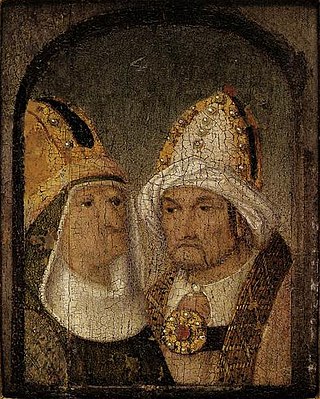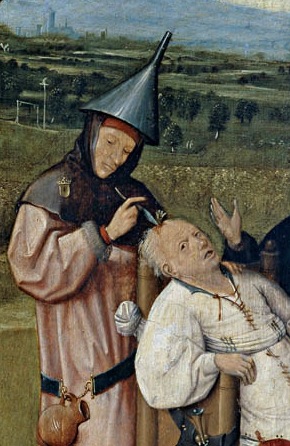
Hieronymus Bosch was a Dutch painter from Brabant. He is one of the most notable representatives of the Early Netherlandish painting school. His work, generally oil on oak wood, mainly contains fantastic illustrations of religious concepts and narratives. Within his lifetime, his work was collected in the Netherlands, Austria, and Spain, and widely copied, especially his macabre and nightmarish depictions of hell.

David Teniers the Younger or David Teniers II was a Flemish Baroque painter, printmaker, draughtsman, miniaturist painter, staffage painter, copyist and art curator. He was an extremely versatile artist known for his prolific output. He was an innovator in a wide range of genres such as history painting, genre painting, landscape painting, portrait and still life. He is now best remembered as the leading Flemish genre painter of his day. Teniers is particularly known for developing the peasant genre, the tavern scene, pictures of collections and scenes with alchemists and physicians.

Ship of Fools is a painting by the Early Netherlandish artist Hieronymus Bosch, now in the Musée du Louvre, Paris. Camille Benoit donated it in 1918. The Louvre restored it in 2015. The surviving painting is a fragment of a triptych that was cut into several parts. This piece, originally part of a larger body of work relating to the seven deadly sins, depicts the sin of gluttony. The Ship of Fools was painted on one of the wings of the altarpiece, and is about two-thirds of its original length. The bottom third of the panel belongs to Yale University Art Gallery and is exhibited under the title Allegory of Gluttony. The other wing, which has more or less retained its full length, is the Death and the Miser, now in the National Gallery of Art, Washington, D.C. The two panels together would have represented the two extremes of prodigality and miserliness, condemning and caricaturing both. The Wayfarer (Rotterdam) was painted on the right panel rear of the triptych. The central panel, if it existed, is unknown.

The Ideal Copy is the fourth studio album by the English rock group Wire, released in April 1987 by Mute Records. It was the first full-length recording following the band's hiatus of 1980–1985. The Ideal Copy peaked at number 87 in the UK albums chart.

The Garden of Earthly Delights is the modern title given to a triptych oil painting on oak panel painted by the Early Netherlandish master Hieronymus Bosch, between 1490 and 1510, when Bosch was between 40 and 60 years old. Bosch's religious beliefs are unknown, but interpretations of the work typically assume it is a warning against the perils of temptation. The outer panels place the work on the Third Day of Creation. The intricacy of its symbolism, particularly that of the central panel, has led to a wide range of scholarly interpretations over the centuries.

Dulle Griet, also known as Mad Meg, is a figure of Flemish folklore who is the subject of a 1563 oil-on-panel by Flemish renaissance artist Pieter Bruegel the Elder. The painting depicts a virago, Dulle Griet, who leads an army of women to pillage Hell, and is currently held and exhibited at the Museum Mayer van den Bergh in Antwerp.
Death and the Miser is a Northern Renaissance painting produced between 1490 and 1516 by the Dutch artist Hieronymus Bosch. The piece was originally part of a triptych, but the center piece is missing. It is a memento mori painting, which is meant to remind the viewer of the inevitability of death and the futility of the pursuit of material wealth, illustrating the sin of greed.

Christ Crowned with Thorns, sometimes known as Christ Mocked, is an oil on panel painting by Hieronymus Bosch. It is held in the National Gallery in London, which dates it to around 1510, though some art historians prefer earlier dates.

Christ Crowned with Thorns is an oil on panel painting made in the 1530s by a follower of Hieronymus Bosch. It is now in the Monasterio de San Lorenzo at El Escorial, near Madrid, in Spain.

The Hermit Saints is a religious oil on panel painting displayed as a triptych which was painted c. 1493 by the Early Netherlandish artist Hieronymus Bosch. The entirety of the triptych painting measures 86 by 60 centimetres. This artwork is currently being housed at the Gallerie dell'Accademia, Venice.

Two Male Heads is an anonymous painting formerly attributed to the Early Netherlandish painter Hieronymus Bosch. It is currently in the Museum Boijmans Van Beuningen in Rotterdam.

Frans Francken the Younger was a Flemish painter and the best-known and most prolific member of the large Francken family of artists. He painted large altarpieces for churches as well as smaller historical, mythological and allegorical scenes. His depictions of collectors' cabinets established a popular new genre of art in the era. Francken often collaborated with other artists, adding figures and narrative elements to scenes created by specialists in landscape, architectural and floral still life paintings.

A tronie is a type of work common in Dutch Golden Age painting and Flemish Baroque painting that depicts an exaggerated or characteristic facial expression. These works were not intended as portraits or caricatures but as studies of expression, type, physiognomy or an interesting character such as an old man or woman, a young woman, the soldier, the shepherdess, the "Oriental", or a person of a particular race.

The stone of madness, also called stone of folly, was a hypothetical stone in a patient's head, thought to be the cause of madness, idiocy or dementia. From the 15th century onwards, removing the stone by trepanation was proposed as a remedy. This procedure is demonstrated in the painting The Extraction of the Stone of Madness by Hieronymus Bosch.

Hieronymus Galle or Hieronymus Galle I or the Elder was a Flemish painter, who specialized in still lifes of fruit and flowers and hunting pieces. He collaborated with his fellow painters on garland paintings, i.e. paintings showing a garland of flowers or fruit around a devotional image or portrait.

The Adoration of the Kings is an oil-on-panel painting of the Adoration of the Magi by the Netherlandish Renaissance artist Pieter Bruegel the Elder, painted in 1564, and now in the National Gallery, London.

The Triptych of Temptation of St. Anthony is an oil painting on wood panels by the Early Netherlandish painter Hieronymus Bosch, dating from around 1501. The work portrays the mental and spiritual torments endured by Saint Anthony the Great, one of the most prominent of the Desert Fathers of Egypt in the late 3rd and early 4th centuries. The Temptation of St. Anthony was a popular subject in Medieval and Renaissance art. In common with many of Bosch's works, the triptych contains much fantastic imagery. The painting hangs in the Museu Nacional de Arte Antiga in Lisbon.
Jheronimus Bosch—Visions of Genius was a 2016 art exhibition at the Noordbrabants Museum in 's-Hertogenbosch, the Netherlands, about the work of Hieronymus Bosch, a native of 's-Hertogenbosch.

Frans Verbeeck or Frans Verbeeck the Elder was a Flemish painter and draughtsman to whom have been attributed a number of works depicting fantastical and grotesque scenes carrying a moralizing intent. He was a member of an important family of artists operating a large workshop with various branches in Mechelen. As it is not always possible to attribute a particular artwork to one or the other family member due to compositional, stylistic, and iconographic similarities, it has been suggested that the works should be attributed to the 'Verbeeck group'. The works were typically executed in tempera or watercolor on linen.

A cranial drill, also known as a craniotome, is a tool for drilling simple burr holes (trepanation) or for creating larger openings in the skull. This exposes the brain and allows operations like craniotomy and craniectomy to be done. The drill itself can be manually or electrically driven, and primarily consists of a handpiece and a drill bit which is a sharp tool that has a form similar to Archimedes' screw, this instrument must be inserted into the drill chuck to perform holes and remove materials. The trepanation tool is generally equipped with a clutch which automatically disengages once it touches a softer tissue, thus preventing tears in the dura mater. For larger openings, the craniotome is an instrument that has replaced manually pulled saw wires in craniotomies from the 1980s.


















